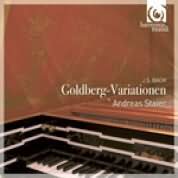If Andreas Staier’s harpsichord–reconstructed after an “authentic” 1734 Hass model–hardly equals the unabashed multi-stop splendor of Wanda Landowska’s “inauthentic” custom-built Pleyel, its ample range of registers and timbres may still bother Goldberg Variations fans accustomed to relatively slimmed-down single-manual Italian instruments. Fortunately, Staier channels his registration choices toward musical ends and imparts a specific character upon each variation with intelligence, discretion, and taste.
He wisely eschews octave couplings in lyrical, melodically elaborate movements like Variation No. 13 and the strikingly delicate No. 15 (the canon at the fifth). At the same time, octave reinforcements establish certain variations (Nos. 10 and 22) as climactic signposts. He plays the famous G minor “Black Pearl” Variation 25 with enormous freedom, and characterizes No. 27 (the canon at the ninth) with playful accents and accelerations.
His unusually ruminative and legato-dominated treatment of the two-manual variations Nos. 2 and 11 may catch listeners off guard, yet he never lets the basic pulse dissipate in the manner of his most recent Harmonia Mundi harpsichord Goldbergs competitor Richard Egarr. Indeed, my only major complaint about Staier’s all-repeats-taken interpretation (including the rarely observed ones in the Aria da capo) concerns the excessively resonant sonics that result in blurring of rapid contrapuntal passages.
An accompanying DVD features Staier demonstrating his instrument and illuminating his interpretive ideas clearly and simply, which is more than I can say for the booklet essay’s philosophical pretensions.
































